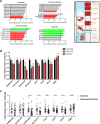Evidence of decreased gap junction coupling between astrocytes and oligodendrocytes in the anterior cingulate cortex of depressed suicides
- PMID: 31374562
- PMCID: PMC6897926
- DOI: 10.1038/s41386-019-0471-z
Evidence of decreased gap junction coupling between astrocytes and oligodendrocytes in the anterior cingulate cortex of depressed suicides
Abstract
Glial dysfunction is a major pathophysiological feature of mood disorders. While altered astrocyte (AS) and oligodendrocyte-lineage (OL) functions have been associated with depression, the crosstalk between these glial cell types has never been assessed in that context. AS are potent regulators of myelination, in part through gap junction (GJ) channels formed by the heterotypic coupling of AS-specific (Cx30 and Cx43) and OL-specific (Cx32 and Cx47) connexins. This study therefore aimed at addressing the integrity of AS/OL coupling in the anterior cingulate cortex (ACC) of depressed suicides. Using immunofluorescence and confocal imaging, we characterized the distribution of Cx30 and mapped its expression onto OL somas, myelinated axons, and brain vasculature in postmortem brain samples from depressed suicides (N = 48) and matched controls (N = 23). Differential gene expression of key components of the GJ nexus was also screened through RNA-sequencing previously generated by our group, and validated by quantitative real-time PCR. We show that Cx30 expression localized onto OL cells and myelinated fibers is decreased in deep cortical layers of the ACC in male-depressed suicides. This effect was associated with decreased expression of OL-specific connexins, as well as the downregulation of major connexin-interacting proteins essential for the scaffolding, trafficking, and function of GJs. These results provide a first evidence of impaired AS/OL GJ-mediated communication in the ACC of individuals with mood disorders. These changes in glial coupling are likely to have significant impact on brain function, and may contribute to the altered OL function previously reported in this brain region.
Figures




Similar articles
-
Coupling of astrocyte connexins Cx26, Cx30, Cx43 to oligodendrocyte Cx29, Cx32, Cx47: Implications from normal and connexin32 knockout mice.Glia. 2003 Dec;44(3):205-18. doi: 10.1002/glia.10278. Glia. 2003. PMID: 14603462 Free PMC article.
-
Repression of Astrocytic Connexins in Cortical and Subcortical Brain Regions and Prefrontal Enrichment of H3K9me3 in Depression and Suicide.Int J Neuropsychopharmacol. 2017 Jan 1;20(1):50-57. doi: 10.1093/ijnp/pyw071. Int J Neuropsychopharmacol. 2017. PMID: 27516431 Free PMC article.
-
Two distinct heterotypic channels mediate gap junction coupling between astrocyte and oligodendrocyte connexins.J Neurosci. 2007 Dec 19;27(51):13949-57. doi: 10.1523/JNEUROSCI.3395-07.2007. J Neurosci. 2007. PMID: 18094232 Free PMC article.
-
Connexin 43/47 channels are important for astrocyte/ oligodendrocyte cross-talk in myelination and demyelination.J Biosci. 2018 Dec;43(5):1055-1068. doi: 10.1007/s12038-018-9811-0. J Biosci. 2018. PMID: 30541963 Free PMC article. Review.
-
Early disruption of glial communication via connexin gap junction in multiple sclerosis, Baló's disease and neuromyelitis optica.Neuropathology. 2015 Oct;35(5):469-80. doi: 10.1111/neup.12211. Epub 2015 May 28. Neuropathology. 2015. PMID: 26016402 Review.
Cited by
-
Biological Factors Underpinning Suicidal Behaviour: An Update.Brain Sci. 2023 Mar 16;13(3):505. doi: 10.3390/brainsci13030505. Brain Sci. 2023. PMID: 36979315 Free PMC article. Review.
-
Astroglia in the Vulnerability to and Maintenance of Stress-Mediated Neuropathology and Depression.Front Cell Neurosci. 2022 Apr 22;16:869779. doi: 10.3389/fncel.2022.869779. eCollection 2022. Front Cell Neurosci. 2022. PMID: 35530179 Free PMC article. Review.
-
Suicide Related Phenotypes in a Bipolar Sample: Genetic Underpinnings.Genes (Basel). 2021 Sep 23;12(10):1482. doi: 10.3390/genes12101482. Genes (Basel). 2021. PMID: 34680877 Free PMC article.
-
Molecular Mechanisms of Glial Cells Related Signaling Pathways Involved in the Neuroinflammatory Response of Depression.Mediators Inflamm. 2020 Oct 10;2020:3497920. doi: 10.1155/2020/3497920. eCollection 2020. Mediators Inflamm. 2020. PMID: 33100903 Free PMC article. Review.
-
Regional changes with global brain hypometabolism indicates a physiological triage phenomenon and can explain shared pathophysiological events in Alzheimer's & small vessel diseases and delirium.Am J Nucl Med Mol Imaging. 2021 Dec 15;11(6):492-506. eCollection 2021. Am J Nucl Med Mol Imaging. 2021. PMID: 35003887 Free PMC article.
References
-
- Miguel-Hidalgo JJ, Baucom C, Dilley G, Overholser JC, Meltzer HY, Stockmeier CA, et al. Glial fibrillary acidic protein immunoreactivity in the prefrontal cortex distinguishes younger from older adults in major depressive disorder. Biol Psychiatry. 2000;48:861–73. doi: 10.1016/S0006-3223(00)00999-9. - DOI - PubMed
Publication types
MeSH terms
Substances
Grants and funding
LinkOut - more resources
Full Text Sources
Research Materials
Miscellaneous

